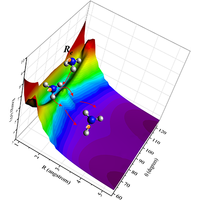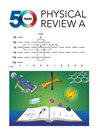低温等离子体中电子撞击解离 NH3 的过程及其同位素效应
IF 2.9
2区 物理与天体物理
Q2 Physics and Astronomy
引用次数: 0
摘要
了解低温氨等离子体中的离解电子附着(DEA)对于许多技术应用,特别是替代能源的应用至关重要。然而,由于电子运动和多维核动力学的复杂相互作用,这一过程的理论建模一直面临挑战。本信提出了一种研究该过程的理论方法,并将其应用于低能电子分解 NH3 分子的过程。计算了 NH3- 5.5 eV 共振态的势能面,以阐明解离过程的机理。然后计算了 NH3 和 ND3 通过 5.5 eV 共振的 DEA 横截面。两个截面的峰值位置和它们之间的比值与以前的实验结果非常吻合。我们的研究结果表明,所建立的理论模型准确地描述了 DEA 过程,可以作为一种有用的工具,为其他分子提供 DEA 截面,从而建立低温等离子体模型。本文章由计算机程序翻译,如有差异,请以英文原文为准。

Process of dissociation of NH3 by electron impact in low-temperature plasma and its isotope effect
Understanding the dissociative electron attachment (DEA) in low-temperature ammonia plasma is crucial for many technological applications, in particular, for alternative energy sources. However, theoretical modeling of this process has been challenging due to the complex interplay of electronic motion and multidimensional nuclear dynamics. This Letter presents a theoretical approach to investigate the process, applying it to the breakup of the molecule by low-energy electrons. The potential energy surface of the 5.5 eV resonant state is computed to elucidate the mechanism of the dissociative process. The cross section of DEA via the 5.5 eV resonance is then calculated for both and . The positions of the peaks in both cross sections and the ratio between them are in excellent agreement with previous experiments. Our findings suggest that the developed theoretical model accurately describes the DEA process and could serve as a useful tool for providing DEA cross sections for other molecules to model low-temperature plasma.
求助全文
通过发布文献求助,成功后即可免费获取论文全文。
去求助
来源期刊

Physical Review A
物理-光学
CiteScore
5.40
自引率
24.10%
发文量
0
审稿时长
2.2 months
期刊介绍:
Physical Review A (PRA) publishes important developments in the rapidly evolving areas of atomic, molecular, and optical (AMO) physics, quantum information, and related fundamental concepts.
PRA covers atomic, molecular, and optical physics, foundations of quantum mechanics, and quantum information, including:
-Fundamental concepts
-Quantum information
-Atomic and molecular structure and dynamics; high-precision measurement
-Atomic and molecular collisions and interactions
-Atomic and molecular processes in external fields, including interactions with strong fields and short pulses
-Matter waves and collective properties of cold atoms and molecules
-Quantum optics, physics of lasers, nonlinear optics, and classical optics
 求助内容:
求助内容: 应助结果提醒方式:
应助结果提醒方式:


